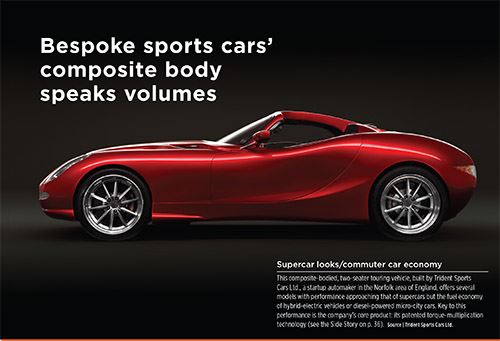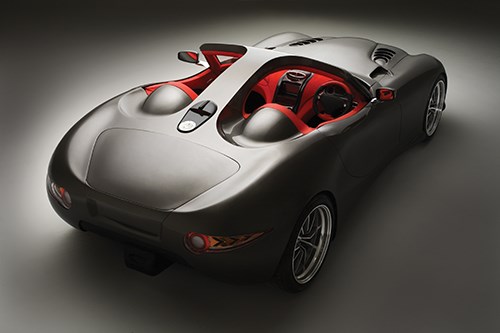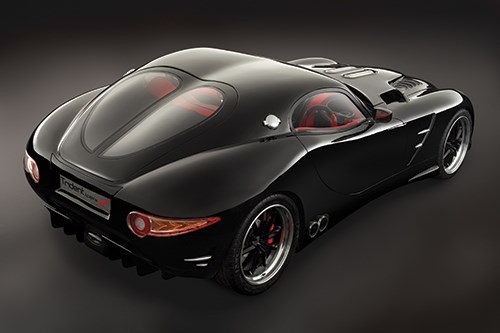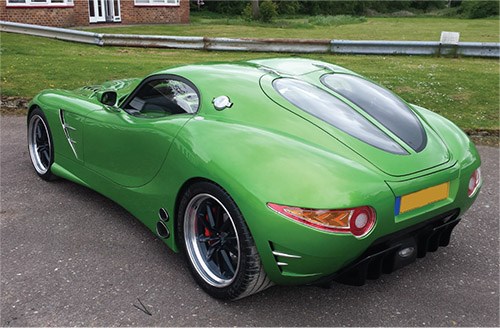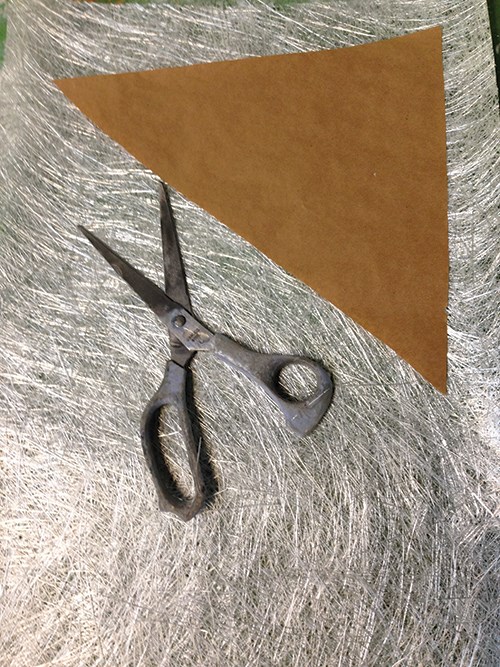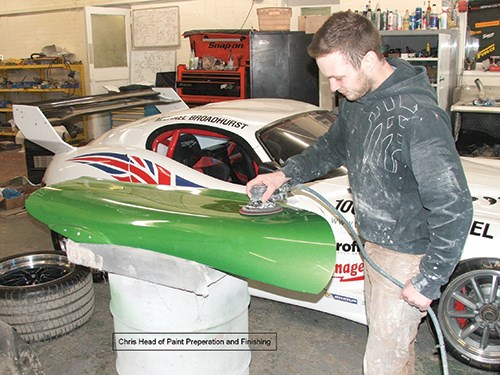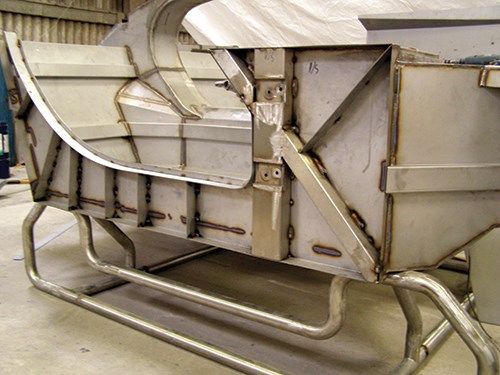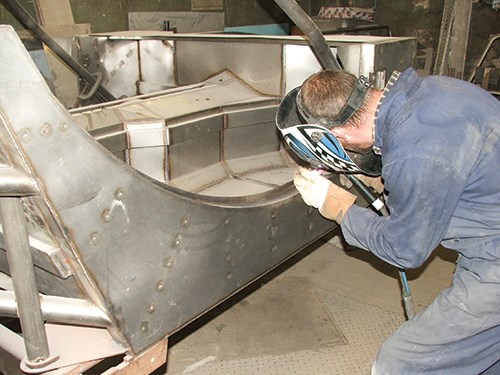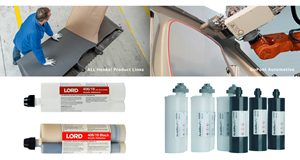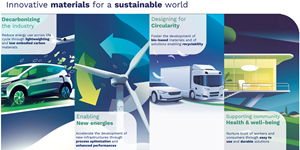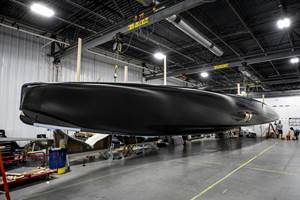Bespoke sports cars’ composite body speaks volumes
Glass-reinforced plastic artfully captures classic curves, crash-protects passengers and stunningly packages its maker’s high-performance but highly fuel-efficient diesel powertrain.
His customers, said Henry Ford, Sr., could buy a car in any color, as long as it was black. Attributed to the founder of Ford Motor Co. (Dearborn, MI, US), this famous quote signaled the end of an era in which nearly everything, even the automobile, was handmade, and thus, could be custom made to order. Ford understood that the secret of mass-producing goods at low cost was to make them all the same, or to greatly reduce choice. Today, when nearly everything purchased in the developed world is mass-produced, there is a powerful longing for that which is personally custom-crafted. Sensing that “old school” undercurrent, startup automaker Trident Sports Cars Ltd. (Swaffham, Norfolk, UK) is using fiber-reinforced plastic (FRP) and a skilled workforce to create bespoke luxury sports cars that showcase a unique transmission technology and multi-fuel engines that can satisfy the very modern imperative to render vehicles carbon neutral in operation.
Marketing massive torque
Trident’s Phil Bevan and partner Dan Monaghan have spent much of their careers working in automotive R&D. But when they opened the doors at Trident in 2005, it wasn’t to develop cars per se, but instead to commercialize their proprietary torque-multiplication technology, the result of a project into which they had sunk ₤6 million (US$9.3 million) of their own money. The vision? Build a business that would manufacture many products — cars, yes, but also commercial trucks, military vehicles, powerboats and even wind turbines — that could incorporate and benefit from that unique technology.
What is torque-multiplication technology? As the name implies, it is a combination of hardware and software algorithms that multiply the torque produced, for example, by an internal combustion engine of a given horsepower rating, enabling it to deliver expected performance at much lower-than-typical engine RPMs, and thus, with greatly reduced fuel consumption; alternatively, it offers extraordinary performance at ordinary RPMs/fuel consumption (for more, see our Side Story titled “Torque-multiplication: A Euro 7-ready diesel supercar?” at the end of this article or click on it's title under "Editor's Picks," at top right). Trident’s potential military vehicle customers, then, would find that, compared to a Humvee or High Mobility Multipurpose Wheeled Vehicle (HMMWV) armored troop carrier from AM General (South Bend, IN, US), which burns fuel at a rate of 34L/100 km on a good day, a Trident military vehicle would deliver fuel ratings of 6-8L/100 km — a big savings for armies or rescue organizations that must carry all their fuel
as they move.
Although their ambition is to be far more than a car company, the partners felt it would be most expedient to showcase their technology on a high-end, two-seat sports car. Thus on display, the Trident powerplant — a modified V8 Duramax diesel engine from General Motors Co. (GM, Detroit, MI, US) — using the company’s torque-multiplication technology and either of Trident’s own six-speed automatic or manual transmissions, would use a mere 4L/100 km. If well executed, they reasoned, this first example would ease technology translation to commercial and military vehicles. Hence, they assembled a team of 30 to build very green sports cars and commercial vehicles. Along the way, they acquired and subsequently modified the name and logo of another automotive icon — a British car company from the 1960s and 1970s called Trident Cars Ltd. — and set up shop in the Norfolk area, also home to another automotive icon, Group Lotus PLC.
Unlike its neighbor, which turns out around 7,000 cars a year, Trident’s goal was to build as many as 500 truly bespoke cars annually that would be as easy on the environment as they were on the eyes. In a consciously ironic nod to certain Italian manufacturers of premium sports cars, their first nameplate, Iceni, bears the name of a Norfolk-based Celtic tribe that, for a time under the leadership of Queen Boadicea, led an uprising that routed the Roman invaders and drove them out of southeast Romano Britain. Time will tell if the name proves prophetic.
Options, options, options!
Although the Iceni is intended as a testament to Trident’s technical capabilities and developmental achievements in the powertrain arena, it is no less important to the company that it have enormous appeal as an automotive achievement. Currently, Trident offers two basic Iceni models: A convertible that features a unique spine/rollbar that extends rearward from its windshield to its seatbacks, and the Magna, which has a fastback coupé design that features a full roll cage (see photos at left).
That said, Trident’s manufacturing philosophy is the antithesis of Henry Ford’s one-color-fits-all philosophy. Icenis are available in any paint color and nearly any color leather interior — even the contrast stitching option on interior trim and seating uses two twisted strands to produce double-color accent stitching (that will be trademarked). Furthermore, the twin double-bubble shaped “Occulite” polycarbonate roof panels are available in six colors. They enhance visibility, extend headspace, protect occupants in a rollover, and store in the boot/trunk when not in use. (The car can be driven with one or both removed and, reportedly, the aerodynamics are so good, occupant hairdos remain undisturbed!) Further, each model can be had plain or dressed up with one of three engine options, front and rear wing vents, side exhausts, and/or twin plenums protruding through the hood (paired with a twin-turbo-charged engine upgrade).
Each vehicle can be further customized through four upgrade packages: track performance; premium-, performance-, and luxury-upgrade packages. And that’s only the beginning. In fact, Icenis feature more than 39 bespoke components — 67% of the car — that are designed and built by the Trident team, including chassis, body panels, wheels, seats, instruments, engine electronic-control module (ECU), gearbox, differential, transaxle, roof panels, head/taillights, and grilles for what the company describes as a “truly unique performance-motoring experience.” Each chassis, for example, is formed from a low-chrome/low-carbon stainless steel that is easily repaired, recyclable and guaranteed for 100 years (see our Side Story titled "Chassis: Unique archtecture and materials," below, or click on its title under "Editor's Picks"). Bevan says every car is built to meet customer needs. Sales are done direct, not through dealers. “We’re in touch with our customers from beginning to end. It’s nearly impossible for us to make two Icenis exactly the same.”
Perfecting the package
Then there’s the no-less-impressive body design. Bevan says a lot of classic cars provided styling cues for the Iceni: “We borrowed the nose cone off a Ferrari and the back windows off a ‘63 [Corvette] Stingray and this and that. When you put it all together, you have a whole new car.”
With a car this fast, this curvy and produced at such low volume, selecting composites for the body panels was a “no-brainer.” The tooling for steel body panels would have been too costly, and aluminum panels couldn’t deliver the vehicle’s plethora of compound surfaces. The Iceni is lusciously curvaceous, and many of those curves play an important safety role. Bevan says they worked from the outside in to shape the car and add as much curve as possible. “Nothing’s straight,” he points out. “We don’t want any stressed members. The body doesn’t have to do anything except make the car safe.” To that end, all models are equipped with crushable composite nose cones. Even the vehicle’s twin-baffle, 50-mm composite “pontoon outriggers,” flared sections near the bottom of door sills, provide protection from side impacts. Because everything bolts to the chassis, rather than to the body, the latter is completely unstressed.
However, when Bevan and his Trident teammates initially looked at carbon fiber prepreg, he says they were disappointed with trial panels, especially for the doors. “Everything sounded awful,” he explains. “The panels were too light for us. We wanted a Grand Tourer vehicle, an expensive product, so we had to get the sound right.”
Because they already had a fairly lightweight chassis, the mass of body panels was less critical. “Torque is the great equalizer to lightweight construction,” Bevan contends, noting that the solution was, therefore, counterintuitive: The team hand lays glass fiber composites with an unsaturated polyester matrix (Crystic 2.446 PALV from Scott Bader Co. Ltd., Wellingborough, Northamptonshire, UK), with a chopped fiberglass core mat (CS mat 92, 300 and 600 g/m2, from Zibo PPG Sinoma Jinjing Fiber Glass Co. Ltd., Zibo, China). “We actually make our panels heavier than is strictly necessary, but when you tap on our body, it sounds like cast iron, not tin. That’s the kind of sound we were after.”
Where extra strength is required, woven mat from the same supplier is used. At the front of the nose cone, for example, near the front grillwork, the layup is straightforward 136 g/m2 chopped strand mat construction, says Bevan. But as the layup progresses rearward toward the bonnet/hood shut line, where the nose cone joins the chassis, techs add a combination of 50-mm woven roving strips, creating an egg-shaped crushable crumple zone, which transitions into the stainless-steel chassis frame member.
Flanges and other hardware are bonded into parts during layup. Panels are cured in a paint-spray booth for 4 hours at 70°C (no vacuum is used). After demolding and degreasing, a polyester spray filler (Lesanol from Akzo Nobel N.V., Abingdon, Oxfordshire, UK) is used to smooth out surface imperfections in the dry-sanded gel coat, and then inner and outer panels are bonded together using a methacrylate adhesive (two-part, rapid-cure MMA 130 from Alsco Ltd., Swindon, Wiltshire, UK) to form a “double skin.” Next, parts are primed with a two-part system and the B-surface is painted (also an AkzoNobel Lesanol grade), then panels are adhesively bonded to the chassis in 24 locations, using top-hat sections. Finally, A-surfaces are painted. Where road noise could intrude, expanded foam is used inside structures, such as around wheel wells and boot/trunk liners. Where shock absorption is important, panels are both bonded and riveted in place.
Bevan acknowledges there are faster ways to make autobody panels, but points out that hand layup supports more employment in the Norfolk area. “Besides, if we sprayed our material, we’d be resin rich, and that would tend to crack more,” he adds. “We’re very careful not to use too much resin. Plus, hand layup gives us a chance to do things more like a GT3 [Cup Grand Touring] race car.”
The resulting Iceni isn’t just beautiful to look at and green to drive, it’s also a force on the track. Last year, the car practiced against British and Italian supercars at the UK’s Silverstone race track (Towcester, Northhamptonshire, UK) and did quite well, and this year it has already out-clocked a McLaren P41 GT Cup car (McLaren Automotive, Woking, Surrey, UK), driving the whole two hours on 52L of fuel, without a single pit stop to refill — what Bevan calls “very grownup, responsible racing.” A significant aspect of that maturity is the car’s zero (net) carbon footprint, a benefit of its capacity for burning bio-diesel fuel.
What’s next?
Trident Motors officially rolled out the Iceni convertible and Iceni Magna late this spring and started taking orders and building vehicles. The manufacturer’s suggested retail price for either model starts at ₤96,000/US$148,500. An “estate” model (sedan with extended roof) called the Iceni Venturer, was set for summer, and a true rear-wheel-drive supercar to compete with the aforementioned Roman invaders is planned for fall. Meanwhile, Trident is working on prototype military vehicles for the United Nations and the North Atlantic Treaty Organization. Next year, the company plans to begin producing left-hand-drive Icenis in Moraine, OH, US for the North American market. For those who love to drive (fast) and love the planet, there’s finally one car in which a driver can find power, performance and fuel economy in a sleek, substantial composite package in almost any color ... something Henry Ford, Sr. couldn’t have anticipated.
Related Content
Adhesives, material solutions promote end market versatility
CAMX 2023: Rudolph Bros. and Co. highlights its role as a prominent specialty chemical distributor and solutions provider with a display of high-performance adhesives, sealants, materials and more from well-known manufacturers.
Read MoreResins, additives, adhesives and 3D printing solutions
CAMX 2023: Arkema’s broad portfolio of products for composites fabricators aim to enhance performance, durability and sustainability.
Read MorePro-Set named official materials supplier for New York Yacht Club American Magic
Competitive sailing team prepares for the 37th America’s Cup beginning in August 2024 with adhesives, resins and laminate testing services for its AC75 monohull construction.
Read MoreHenkel releases digital tool for end-to-end product transparency
Quick and comprehensive carbon footprint reporting for about 58,000 of Henkel’s adhesives, sealants and functional coatings has been certified by TÜV Rheinland.
Read MoreRead Next
All-recycled, needle-punched nonwoven CFRP slashes carbon footprint of Formula 2 seat
Dallara and Tenowo collaborate to produce a race-ready Formula 2 seat using recycled carbon fiber, reducing CO2 emissions by 97.5% compared to virgin materials.
Read MoreVIDEO: High-volume processing for fiberglass components
Cannon Ergos, a company specializing in high-ton presses and equipment for composites fabrication and plastics processing, displayed automotive and industrial components at CAMX 2024.
Read More“Structured air” TPS safeguards composite structures
Powered by an 85% air/15% pure polyimide aerogel, Blueshift’s novel material system protects structures during transient thermal events from -200°C to beyond 2400°C for rockets, battery boxes and more.
Read More
.jpg;width=70;height=70;mode=crop)
